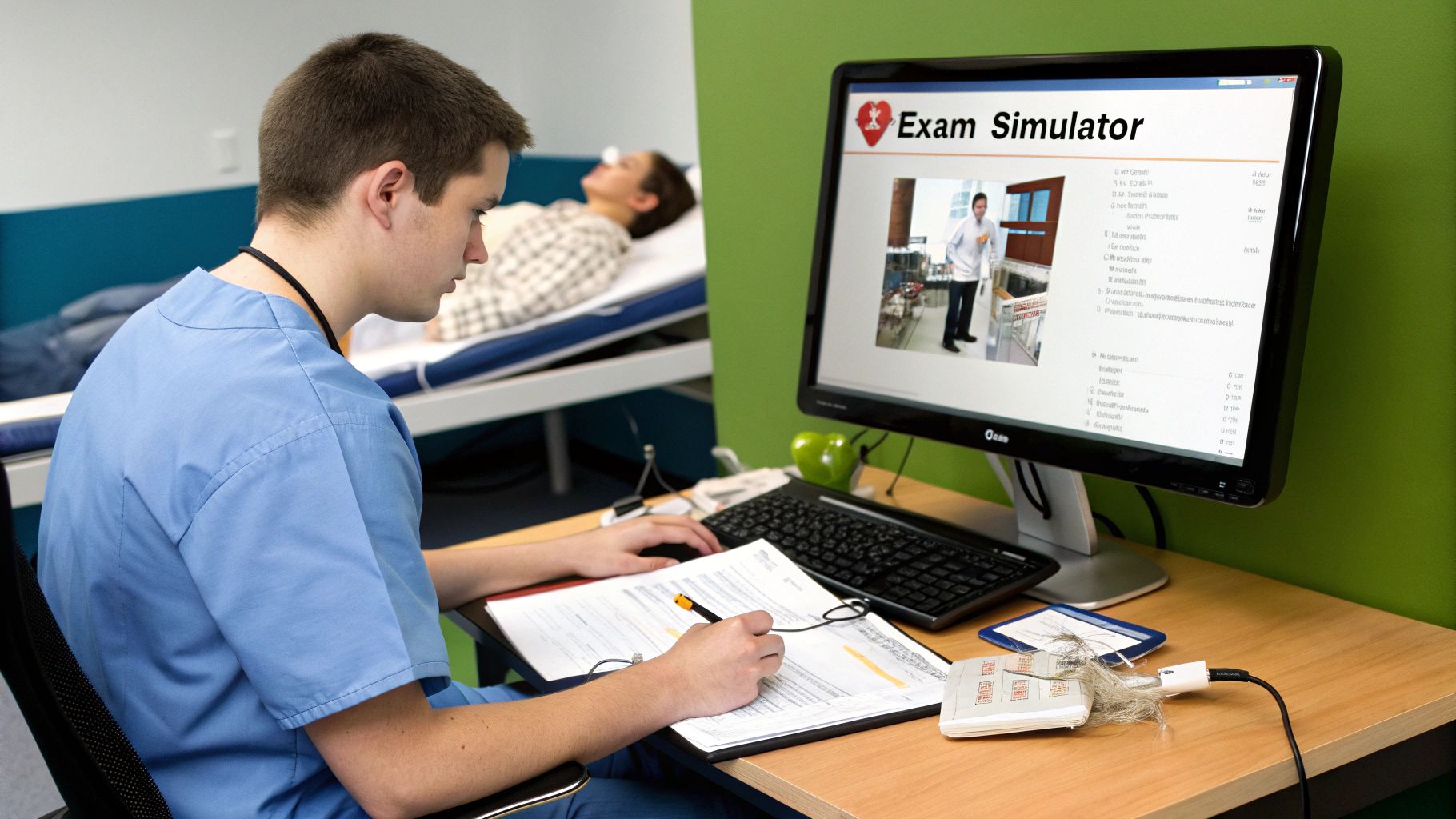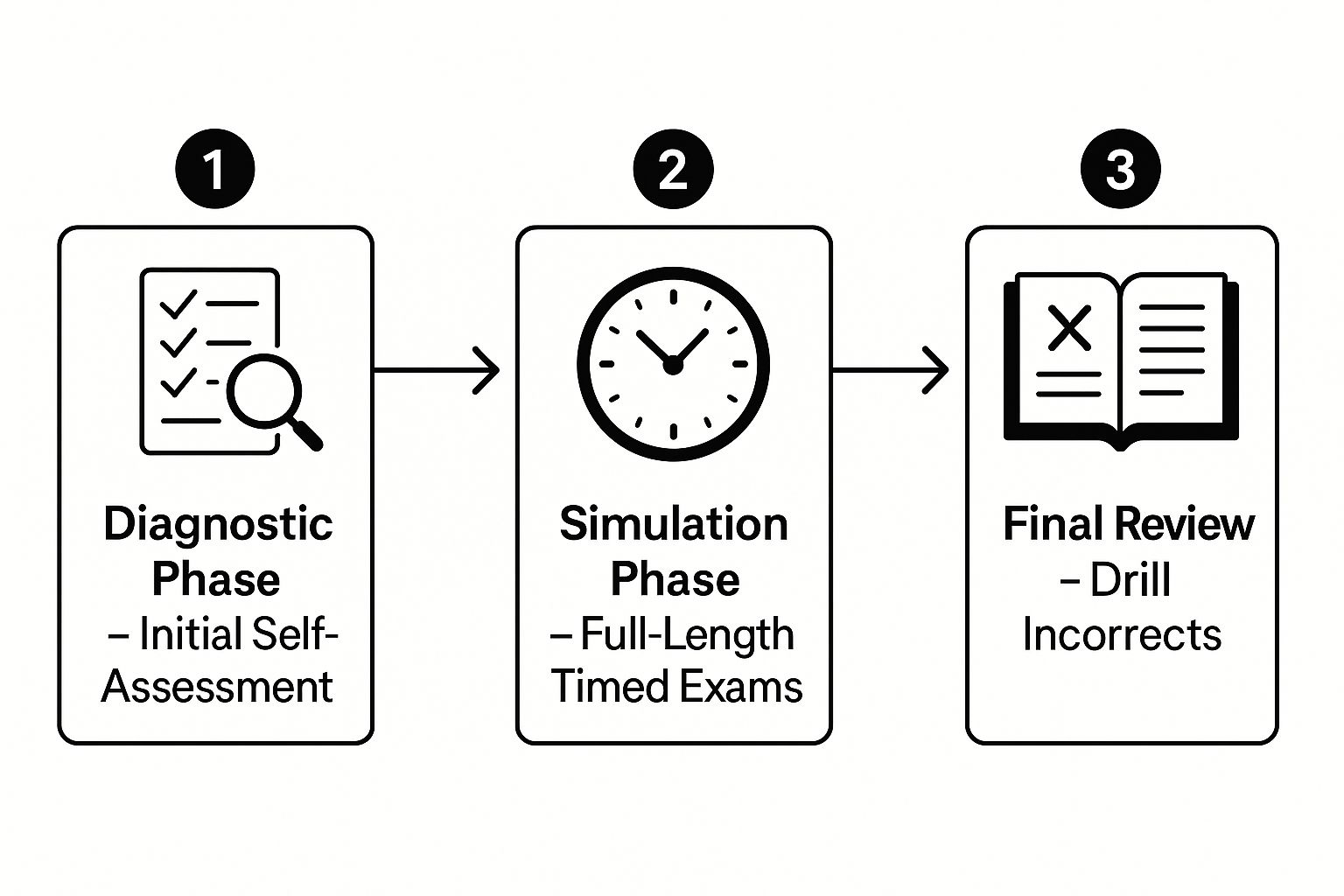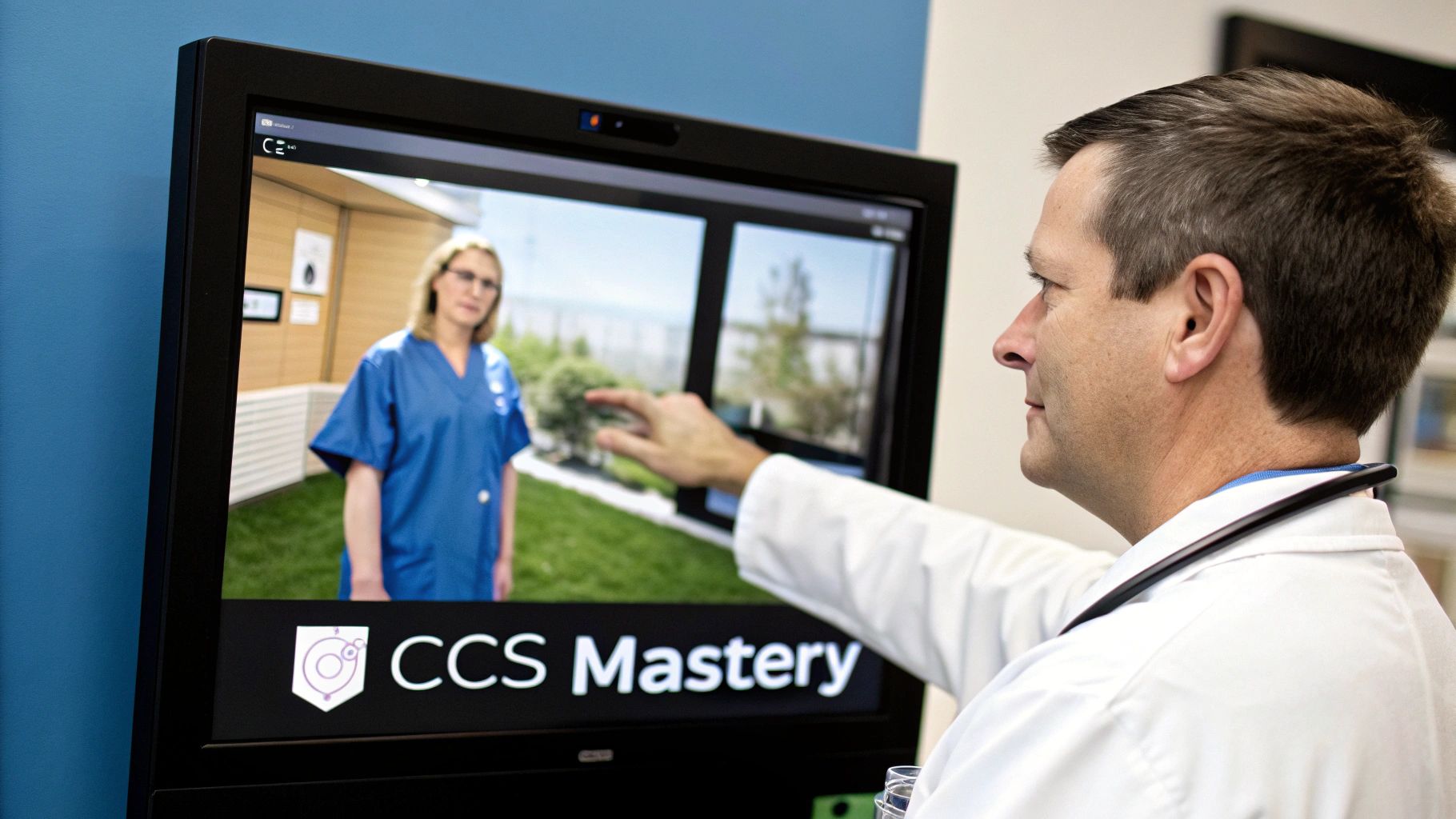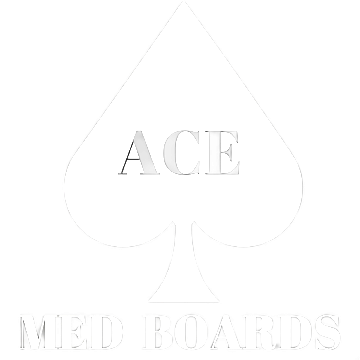When you're staring down the barrel of the USMLE Step 3, practice tests aren't just a helpful study aid—they are the single most important tool in your arsenal. This isn't like the earlier Steps. Success here is all about applying your clinical knowledge under serious pressure, especially during the Computer-based Case Simulations (CCS). For that reason alone, practice is non-negotiable.
Why Step 3 Practice Tests Are Your Most Critical Tool

It helps to think of Step 3 not as just another exam, but as the final dress rehearsal before you get your independent medical license. This is a two-day marathon designed to see if you can truly blend foundational science with the split-second decisions of patient management. The real challenge isn’t just recalling isolated facts; it's about applying clinical reasoning when the clock is ticking.
This is exactly where USMLE Step 3 practice tests become your best friend. They’re like a flight simulator for a pilot. You wouldn't want your first real flight to be with a plane full of passengers, and you definitely don’t want to face the live exam without logging serious hours in the simulator first.
Simulating the Two-Day Marathon
The structure of this exam is a beast, split across two very different days that test different parts of your brain.
- Day 1 (Foundations of Independent Practice): This day has a more traditional feel. It's heavy on multiple-choice questions covering basic sciences, biostatistics, and how to interpret medical literature.
- Day 2 (Advanced Clinical Medicine): This is where the rubber meets the road. It mixes more multiple-choice questions with 13 Computer-based Case Simulations (CCS), where you're in the driver's seat, managing a patient from workup to discharge.
Without practice, the sheer mental fatigue and tricky pacing of this format can completely overwhelm you. Good practice tests train you to manage your time, get comfortable with the clunky CCS software, and build the stamina you’ll need to survive a nine-hour testing day.
Passing Step 3 isn’t just about what you know—it's about how you perform under pressure. Practice tests build the bridge between your knowledge and a passing score. They train the clinical decision-making muscles you need for both the multiple-choice questions and the incredibly important interactive case simulations.
The Data Speaks Volumes
The numbers don't lie. According to the official performance data, the pass rate for first-time takers from US/Canadian MD programs was a solid 97% in 2023. But for those who had to repeat the exam? That rate plummeted to just 77%.
That huge drop-off shows just how tough it is to recover from a first-time failure. You can see the full USMLE Step 3 performance data for yourself on the official site. This stark difference really hammers home the value of using practice tests to make sure you're one and done.
Navigating the Step 3 Practice Resource Landscape
Trying to figure out your Step 3 prep can feel like assembling a complex piece of furniture with the instructions written in another language. There’s a dizzying array of resources out there, and every single one claims to be the secret to your success.
Let's simplify this. Think of your study materials not as a random pile of books and apps, but as a highly specialized toolkit. Each tool has a specific, crucial job. You wouldn't use a sledgehammer to fix a watch, and you can’t rely on just one resource for a multifaceted exam like Step 3. That’s a surefire way to get frustrated.
A smart strategy comes from understanding what each resource brings to the table and how they all fit together. A question bank is fantastic for building knowledge, but it won't perfectly predict your score. An official practice test is great for a score prediction, but it won't teach you the nuances of patient management. Each piece has its purpose.
Your Core Toolkit: The Three Main Resource Types
The best USMLE Step 3 practice tests and study aids fall into three essential categories. If you want to cover all your bases—from foundational knowledge to the unique challenge of managing simulated patients—you’ll need to integrate all three.
Official NBME Self-Assessments: These are the official blueprints, straight from the people who write the actual exam. Their main job is to give you a predictive score and a true feel for the question style and difficulty you'll see on test day.
Third-Party Question Banks (Qbanks): Think of these as your heavy-duty power tools. Platforms like UWorld and AMBOSS are packed with thousands of multiple-choice questions designed to build and drill your core knowledge. They are absolutely essential for daily practice and learning from their incredibly detailed explanations. For a closer look, check out our guide to high-yield USMLE Step 3 practice questions.
Dedicated CCS Case Software: This is your specialized, precision instrument. The Computer-based Case Simulations (CCS) are a huge, heavily weighted part of Step 3. This software lets you practice the specific workflow, timing, and order entry you need to master these interactive scenarios.
To make it even clearer, here’s a quick comparison of the main players in your Step 3 toolkit.
Comparison of Key USMLE Step 3 Practice Resources
This table breaks down the primary purpose and key features of the essential Step 3 resources, helping you understand when and why to use each one.
| Resource Type | Primary Purpose | Key Features | Best For |
|---|---|---|---|
| NBME Self-Assessments | Score Prediction & Realism | Authentic exam questions, timed blocks, and a predicted 3-digit score. | Gauging readiness and identifying weak areas before the real exam. |
| Question Banks (Qbanks) | Knowledge Building | Thousands of questions, detailed explanations, and performance analytics. | Daily study, reinforcing concepts, and improving timing on MCQs. |
| CCS Software | Simulation Mastery | Interactive case simulations that mimic the official exam software. | Learning the unique format and developing a systematic approach to cases. |
By seeing them side-by-side, it's easier to see how each resource fills a different, critical need in your overall study plan.
Building a Cohesive Strategy
Just having the tools isn't enough; you need a plan for how to use them together. Most residents start with a Qbank to build their knowledge base, working through questions system by system. As the real exam gets closer, they start weaving in NBME Self-Assessments to benchmark their progress and get used to the grueling pace of the test.
The most common mistake is pushing off dedicated CCS practice until the last minute. The CCS portion of the exam tests a completely different skill set—clinical management under pressure—which you can only develop with consistent, focused practice.
Don’t treat CCS practice as an afterthought. It should be a parallel track in your studies from early on. This balanced approach is what turns a potentially overwhelming exam into a manageable process of building and refining your skills, ensuring you’re ready for every part of the two-day marathon.
How to Choose the Right Practice Tests for You

Alright, you've seen the landscape of available resources. Now comes the crucial part: picking the tools that will actually work for you. Forget the idea of a single "best" USMLE Step 3 practice test. The best ones are those that fit neatly into your schedule, your budget, and—most importantly—your specific learning gaps.
Think of it like building a custom toolkit for a complex job. You wouldn't just grab the most popular wrench; you'd select the precise instruments needed for the task at hand. This is about moving past the marketing hype and focusing on the features that will directly shore up your weaknesses. This is the difference between just studying and studying smart.
Evaluate Key Resource Attributes
Before you drop any cash or commit precious study hours, you need to vet your options against a few non-negotiable criteria. Each one plays a huge role in getting you ready for the real deal.
Interface Realism: How closely does the platform mimic the actual exam software? This isn't just a cosmetic detail. For the Computer-based Case Simulations (CCS), being familiar with the interface can save you critical minutes and slash your test-day anxiety.
Explanation Quality: Are the answer explanations deep and genuinely helpful? A top-tier Qbank doesn't just circle the right answer. It walks you through the "why"—explaining the core concept and dissecting why every other option was wrong.
Performance Analytics: Can you see where you're stumbling? Look for tools that give you detailed feedback. You need to be able to spot patterns in your mistakes, track how long you're spending per question, and see how you stack up against your peers.
These three factors are what separate a simple list of questions from a powerful diagnostic and learning machine.
The most valuable practice test is the one that reveals your blind spots. If your knowledge base is solid but you're constantly running out of time, you need a Qbank with killer performance analytics. If CCS cases give you nightmares, a dedicated simulation platform isn't just a good idea—it's essential.
Aligning Resources with Your Needs
Your real-life situation has to be part of the equation. A resident grinding through a tough surgical rotation has completely different study needs than one in a more predictable outpatient block. Be brutally honest with yourself about your strengths, your weaknesses, and how much time you can realistically carve out.
For example, if biostatistics questions are your bread and butter, you probably don't need to splurge on a specialized biostats review book. But if you find yourself rushing through MCQ blocks, a Qbank that lets you create timed, random sets is an absolute must. Making these choices isn't just smart studying; it's smart budgeting.
The cost of prep is a real investment in your career, and you have to plan for it. In 2025, the Step 3 application fee is $935, and it's set to increase to $955 in 2026. That fee is non-refundable. Given the steep price tag, spending a bit more on the right practice materials to ensure you pass on the first try is a sound financial decision. You can learn more about the USMLE Step 3 fees and policies to get a full picture of the costs involved.
Building Your Winning Step 3 Study Schedule
Having the best USMLE Step 3 practice tests on hand is a great start, but it's only half the story. Without a solid plan, even the most premium resources won't get you across the finish line. A winning study schedule isn't about cramming more hours into your already packed intern life; it's about a smart, phase-based approach that builds your knowledge, stamina, and confidence over time.
Think of it like training for a marathon. You don't just show up on race day and hope for the best. You start with shorter runs, build your endurance, and do full dress rehearsals before the main event. This phased approach ensures you cover all your bases, from patching up weak spots to simulating the grueling two-day exam.
Phase 1: The Diagnostic Phase
Your journey has to start with an honest look in the mirror. Before you dive headfirst into thousands of practice questions, you need a map of where you stand right now. Taking a baseline NBME Self-Assessment or a full-length practice exam at the very beginning is your diagnostic tool.
The goal here isn't to ace it—far from it. You're looking for patterns. Are you rusty on biostats? Is pediatric management your kryptonite? This initial data is pure gold. It allows you to customize your study plan and focus your limited energy where it’ll make the biggest difference.
Phase 2: The Learning Phase
Once you’ve identified your weak areas, it’s time to get to work. This is the learning and practice phase, and it’s where you'll spend most of your prep time. You'll be living in a question bank like UWorld or AMBOSS, grinding through questions to build both your knowledge base and the mental endurance for long blocks.
Here's a practical way to tackle it:
- System-Based Grinding: Focus on one organ system at a time (e.g., conquer Cardiology, then move on to Pulmonology). This helps consolidate related concepts.
- Timed vs. Untimed: Start with untimed blocks. The goal is to deeply understand the concepts, not just race the clock. As you get more comfortable, switch to timed blocks to sharpen your pacing.
- Review Everything: This is critical. Never just glance at the right answer and move on. Spend real time dissecting the explanations. You need to know why the right answer is correct and, just as important, why every other option is wrong.
This phase is all about repetition and volume. You’re cementing those high-yield facts until they become second nature.
Phase 3: The Simulation Phase
As your test date gets closer, your focus needs to pivot from just acquiring knowledge to mastering performance. This is the simulation phase, where you take full-length USMLE Step 3 practice tests under strict, exam-like conditions. No distractions, no extra time.
This infographic breaks down how to weave practice tests into your study flow.

This roadmap shows the natural progression from your first diagnostic test to the final, intense dress rehearsals before the real exam.
The whole point of the simulation phase is to battle-test yourself against test-day variables: fatigue, anxiety, and the relentless clock. It’s your chance to figure out your break strategy and build the mental toughness for a two-day, 16-hour beast of an exam.
It's also worth remembering why this score still matters. While Step 1 went pass/fail, Step 3 gives you a numerical score, with 200 as the minimum passing mark. If you have your sights set on a competitive fellowship, a high Step 3 score can absolutely give you an edge.
Phase 4: The Final Review Phase
In the last one to two weeks, it's time to narrow your focus. Stop trying to learn new material. Instead, concentrate on drilling the questions you got wrong on your practice tests and Qbanks. This is also the time to hammer home biostats, ethics, and patient safety—these topics are guaranteed to show up and are often easy points if you’re prepared.
As you polish your study plan, it can be helpful to explore different learning aids; you might be surprised by the impact of AI text-to-speech on education for reviewing notes on the go. For a more detailed, day-by-day plan, our comprehensive Step 3 study schedule guide provides a fantastic template to get you started.
A Practical Game Plan for Mastering CCS Cases

Let's be honest: for most residents, the Computer-based Case Simulations (CCS) are the most daunting part of Step 3. It’s a totally different beast. Unlike a multiple-choice question with one right answer, here you’re graded on the entire process of managing a patient. This is your guide to turning that intimidation into a major strength.
Success in the CCS section isn't about memorizing obscure facts. It’s all about having a rock-solid, systematic workflow. The scoring algorithm is designed to reward thorough, safe, and efficient clinical decision-making. It will absolutely penalize you for missing critical steps, shotgunning unnecessary tests, or—most importantly—failing to react when your patient’s condition changes. Every single order you place and every minute that ticks by is being tracked.
Adopting a Systematic Workflow
The secret is to develop a routine you can repeat for every single case, no matter the chief complaint. This approach stops you from panicking and ensures you cover all the essential bases, whether you're facing a straightforward asthma exacerbation or a complex multi-system trauma.
Your first few moves are critical. As soon as a case starts, begin with a focused physical exam tailored to the chief complaint. Don't delay placing your essential initial orders: get vitals, put the patient on continuous monitoring if there's any indication, and establish IV access. Get the basics done.
A classic rookie mistake is ordering every lab test imaginable right out of the gate. The CCS system rewards a stepwise, logical approach. Place your initial labs and imaging, then advance the clock to see the results before deciding on your next move. This shows the system you're thinking like a clinician, not just checking boxes.
This structured process ensures you don't miss fundamentals while you gather the data you need for the bigger decisions.
Mastering Clock Management and Case Flow
The clock is your most powerful tool in the CCS interface, and learning how to manage it is a skill in itself. This is something you absolutely must practice.
Advancing the clock in short bursts (think 5-10 minutes) is perfect for seeing the immediate results of STAT orders or reassessing an unstable patient. Longer jumps ("until next decision point") are best reserved for stable patients while you wait for routine labs to come back.
What really separates a good score from a great one is recognizing subtle changes in a patient's status from minimal data. A slight dip in blood pressure or a new low-grade fever isn't just noise—it's a signal. It should immediately trigger a re-evaluation and a fresh set of orders. To really nail this down, check out our in-depth guide on navigating Step 3 CCS cases.
Interestingly, understanding the principles of structured scenario analysis can give you a real edge. This systematic way of thinking helps you anticipate potential outcomes and plan your actions logically—which is the core skill for crushing these simulations. With a clear game plan and plenty of practice, you can walk in ready to handle any case they throw at you.
Turning Practice Test Data into a Higher Score
Finishing one of the many USMLE Step 3 practice tests is just the starting line. The real work—the kind that actually bumps up your score—kicks in when you start digging into your results with a meticulous and brutally honest review. This is where you stop guessing and start building a real strategy based on data.
Simply scrolling through to see what you got right or wrong is a massive wasted opportunity. You need to put on your detective hat and start analyzing your own performance to uncover the hidden patterns holding you back. This deep dive is what separates a passing score from a great one, especially when a strong performance can open doors to competitive fellowships.
When you analyze your mistakes this way, you turn a passive review into an intelligent tool for growth. It ensures every single hour you put in moves you closer to your goal on exam day.
Creating an Error Analysis System
To get the most out of your practice tests, you need a system. It doesn’t have to be complicated—a simple spreadsheet or log will do. Every time you review a block of questions, you’re going to categorize the reason you missed each one.
This isn't about beating yourself up; it's about getting surgically precise about the root cause of your errors. A typical breakdown might look something like this:
- Knowledge Gap: You flat-out didn't know the fact or concept being tested. Simple as that.
- Misread the Question: You rushed and blew past a keyword like "except," "not," or "most likely."
- Overthought the Answer: You talked yourself out of the right choice, probably second-guessing a good gut instinct.
- Calculation Error: A simple math mistake on a biostats problem cost you the point.
- Time Pressure Mistake: The clock was ticking down, you felt the pressure, and made a sloppy decision you normally wouldn't.
After just a couple of tests, tracking this data will start to reveal your personal performance trends with shocking clarity.
From Patterns to Actionable Insights
Once you’ve reviewed a few practice exams, your error log starts to tell a story. You might discover that 70% of your mistakes have nothing to do with a lack of knowledge. Instead, they’re happening because you consistently misread questions in the last 10 minutes of a block. That’s not a content problem; it's a pacing and fatigue issue.
The most powerful insight from a practice test isn't just what you got wrong, but why. Understanding your unique error patterns allows you to stop studying harder and start studying smarter, focusing your energy on the actions that will actually raise your score.
This data-driven approach lets you make specific, targeted changes to your study plan. If knowledge gaps in cardiology are tanking your score, you know to schedule extra study sessions for that system. But if time pressure is the real culprit, the solution is hammering out more timed practice blocks to build up your stamina and speed.
Modern Qbanks and self-assessment tools often have built-in analytics that let you dive even deeper. These platforms can track your performance by subject, system, and even question type, handing you a detailed roadmap for improvement. This systematic review process is the engine that drives meaningful score improvement, turning every practice test into a powerful step toward success.
Your Top Questions About Step 3 Practice, Answered
As you gear up for the final hurdle of the USMLE, it’s natural to have questions. This isn't just another test—it's the last one. Let's tackle some of the most common queries residents have about using USMLE Step 3 practice tests so you can build your study plan with confidence.
How Many Practice Tests Should I Really Take?
There isn't a single magic number here, but there's definitely a winning formula. Most residents who pass comfortably take at least two full-length NBME Self-Assessments. Think of these as your dress rehearsals—they're crucial for gauging your readiness and getting a reliable predicted score.
But that's only part of the picture. The real heavy lifting comes from grinding through a major question bank like UWorld. Completing most—if not all—of a QBank means you’re tackling thousands of individual questions. This is what builds the deep knowledge base and mental stamina you need for a two-day exam. The goal isn't just to do the tests; it's to bleed every drop of learning from them through careful, methodical review.
When Should I Start Practicing CCS Cases?
Whatever you do, don't leave the Computer-based Case Simulations (CCS) for the last week. That's a recipe for panic. A smart timeline is to start introducing CCS practice about 4-6 weeks before your exam day. This gives you plenty of breathing room to get the hang of the quirky software and master the basic principles of case management without feeling frantic.
Then, as you hit the final few weeks, it's time to ramp up. You should be running through several cases every single study day. This isn't just about knowing the medicine; it's about building the muscle memory and timing needed to navigate the software smoothly under pressure. Repetition is what builds the confidence to crush this high-stakes section of the exam.
Remember, the skills tested in CCS cases—systematic patient management under pressure—are different from those tested in multiple-choice questions. Consistent, dedicated practice is the only way to develop the muscle memory needed to perform well.
Are the Free USMLE Practice Materials Enough on Their Own?
The official free practice materials from the USMLE are a fantastic and absolutely essential starting point. You have to use them. They're the only way to get a true feel for the real exam's interface, question style, and the CCS software.
However, relying on them alone is a big mistake. The free materials simply don't have the volume of questions you need for thorough prep. More importantly, they lack the detailed, high-yield explanations that premium resources like NBME self-assessments and dedicated QBanks provide. Those explanations are where the real learning happens—they're what helps you find and patch the knowledge gaps standing between you and a passing score.
At Ace Med Boards, we specialize in turning practice into performance. Our expert tutors provide personalized guidance to help you master every aspect of the Step 3 exam, from MCQs to CCS cases. Start with a free consultation and build a study plan that gets results. Learn more at Ace Med Boards.
